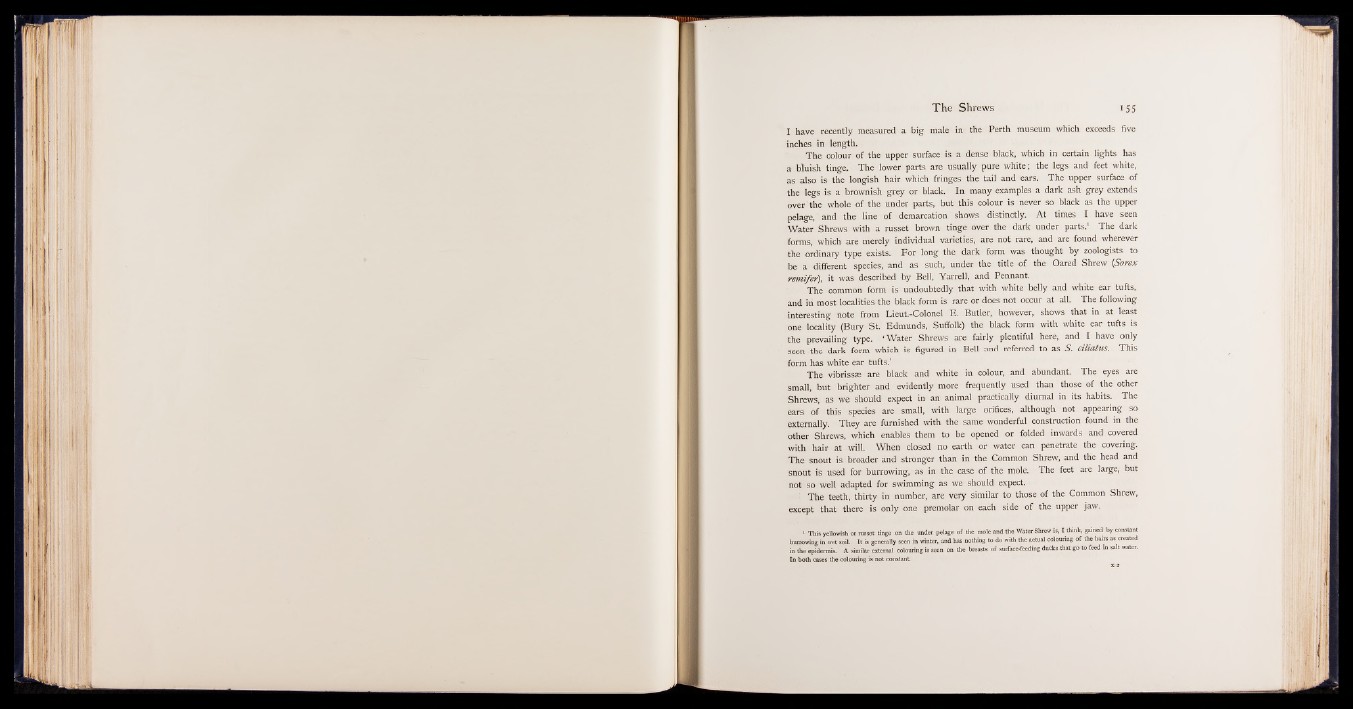
T h e Shrews 155
I have recently measured a big male in the Perth museum which exceeds five
inches in length.
The colour of the upper surface is a dense black, which in certain lights has
a bluish tinge, The lower parts are usually pure white; the legs and feet white,
as also is the longish hair which fringes the tail and ears. The upper surface of
the legs is a brownish grey or black. In many examples a dark ash grey extends
over the whole of the under parts, but this colour is never so black as the upper
pelage, and the line of demarcation shows distinctly. At times I have seen
Water Shrews with a russet brown tinge over the dark under parts.1 The dark
forms, which are merely individual varieties, are not rare, and are found wherever
the ordinary type exists. For long the dark form was thought by zoologists to
be a different species, and as such, under the title of the Oared Shrew (Sorex
remi/er), it was described by Bell, Yarrell, and Pennant.
The common form is undoubtedly that with white belly and white ear tufts,
and in most localities the black form is rare or does not occur at all. The following
interesting note from Lieut.-Golonel' E. Butler, however, shows that in at least
one locality (Bury St. Edmunds, Suffolk) the black form with white ear tufts is
the prevailing type. ‘Water Shrews are fairly plentiful here, and I have only
seen the dark form which is figured in Bell and referred to as S', ctliatus. This
form has white ear tufts.’
The vibrissae are black and white in colour, and abundant. The eyes are
small, but brighter and evidently more frequently used than those of the other
Shrews, as we should expect in an animal practically diurnal in its habits. The
ears of this species are small, with large orifices, although not appearing so
externally. They are furnished with the same wonderful construction found in the
other Shrews, which enables them to be opened or folded inwards and covered
with hair at will. When closed no earth or water can penetrate the covering.
The snout is broader and stronger than in the Common Shrew, and the head and
snout is used for burrowing, as in the case of the mole. The feet are large, but
not so well adapted for swimming as we should expect.
: The teeth, thirty in number, are very similar to those of the Common Shrew,
except that there is only one premolar on each side of the upper jaw.
1 This yellowish or russet tinge on the under pelage of the mole and the Water Shrew is, I think, gained by constant
burrowing in wet soil. It is generally seen in winter, and has nothing to do with the actual colouring of the hairs as created
in the epidermis. A similar external colouring is seen on the breasts of surface-feeding ducks that go to feed m salt water.
In both cases the colouring is not constant.